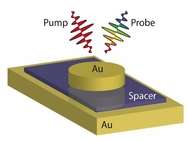Fast times and hot spots in plasmonic nanostructures

The ability to control the time-resolved optical responses of hybrid plasmonic nanostructures was demonstrated by a team led by scientists in the Nanophotonics Group at the Center for Nanoscale Materials including collaborators at Argonne's Materials Science Division, Emory University, and Ohio University.
Anomalously strong changes to the ultrafast temporal and spectral responses were observed depending upon the geometry and the composition of the nanosystems, and the excitation wavelength. The team observed a large ultra-fast contribution to the transient signal in plasmonic nanostructures with hot spots. Modeling efforts show that the intensity of this contribution correlates with the efficiency of the generation of highly excited surface charges in the nanostructures. The large ultra-fast component is attributed to the efficient generation of hot plasmonic electrons in hot spots. The study develops and demonstrates the principles to generate energetic electrons using specially-designed plasmonic nanostructures that can be utilized in the areas of solar photocatalysis, photodetectors and nonlinear devices.
Light-matter interaction in metallic nanosystems is governed by the collective oscillation of their surface electrons, called plasmons. After excitation, plasmons in metallic nanoparticles are absorbed by the metal electrons through inter- and intraband transitions creating a non-thermal distribution of electrons. The excited electrons equilibrate through electron-electron interactions creating a hot electron distribution within a few hundred femtoseconds (fs), followed by a further relaxation via electron-phonon scattering on a few picoseconds (ps) time scale. In the spectral domain, the excited electrons induce changes to the plasmonic resonances of the particles by modifying the dielectric constant of the metal.
These results provide a path for tuning the ultrafast response of engineered nanoparticle structures for a desired time and optical response. This work developed the principles for generating plasmons and can be utilized in a variety of applications including photo-catalysis, photodetectors and nonlinear devices. CNM capabilities included fabrication, ultrafast spectroscopy, extinction spectroscopy, and molecular modeling (COMSOL).
More information: "Anomalous ultrafast dynamics of hot plasmonic electrons in nanostructures with hot spots." Nature Nanotechnology (2015) DOI: 10.1038/nnano.2015.165
Journal information: Nature Nanotechnology
Provided by Argonne National Laboratory




















